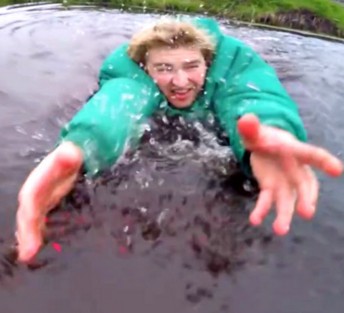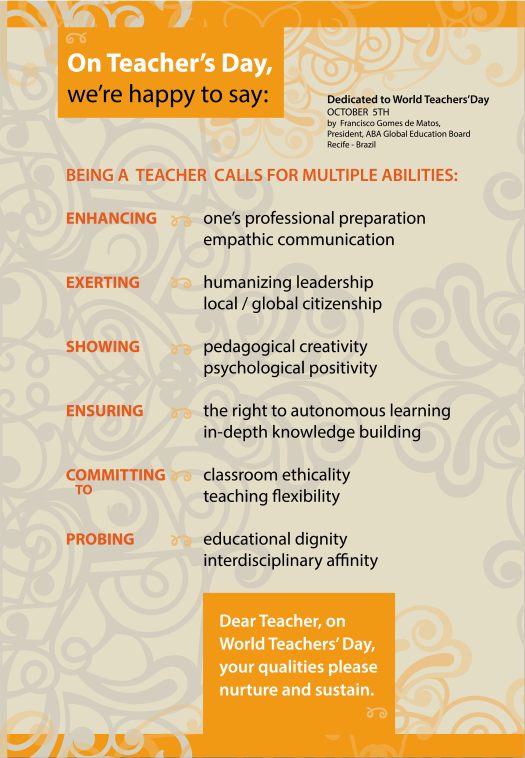Letter 1
Hello Hania
I hope you had a good August. I spent mine in Barcelona. It's been fun but now it's back to work!
So, first of all, I have just uploaded a new video activity on Lessonstream. It is called Would you rather?. The activity makes use of questions such as: "Would you rather spend a month in prison or two years alone on a desert island?"
You can see the video and download the lesson plan here.
Jamie Keddie
Letter 2
Dear Hania
sharing info on a possibly pioneering chapter of mine in which I relate Human Rights to second language learners` right to translate. The source was included in the MLA International Bibliography (1991).
Best
Francisco Gomes de Matos
Letter 3
On the History of Language Teaching: rhymed reflections
First, there was a universally spread practice of Reading+ Grammar-Translation
Then the teaching of spoken language became a pedagogical preoccupation
The early influence of Linguistics was felt through word and sentence formation
Now,users and uses of language(s)have become a major crosscultural consideration
Between Discourse and Language Teaching there will not be a separation
May the advent of Peace Linguistics give anguage Teaching a deeper foundation
On global happiness
When pleasure we show or enjoy
Can we say there is an intense joy?
When happiness to others we wish to bring
What cheerful songs should we sing ?
When a happy Humankind will there be ?
When governments everywhere
on a sustainable peace will agree
Why is Global Happiness hard to achieve?
Because in a peaceful,nonviolent,
nonkilling Life life all human beings
would have to believe
Humor in language education: A rhymed reflection
In Language Education, an attractive role humor can play
When a sense of humor colors what language users say
When humor in course contents is integrated
Language learners are amusingly educated
When is Life seriously laughable ? When humor is dignifying
In language education classrooms, humor let`s cultivate
and more entertainingly we`ll be able to educate
a peace linguist, president of the Board,
ABA Global Education,Recife,Brazil
Francisco Gomes Cardoso Gomes de Matos
Letter 4
Hello Hania
I hope you are having / had a good weekend!
I have just posted a new videotelling activity on Lessonstream. The activity is titled Great Catch and makes use of a simple technique that I like. Students get a list of isolated items from a story (in this case a viral video) and have to predict what happens. In this case, the items are as follows:
A DJI Phantom (a mystery item to many!)
A cold day in December
A ditch filled with ice-cold water
Fully clothed
Over 4 million views

You can see the video and download the lesson plan here.
My videos…
Some videos that you might like to share with your students:
- English grammar at its most basic (Video here)
- Owning English? (Video here)
- The names of the fingers in English (Video here)
Jamie Keddie
Letter 5
Hi Hania
More on Kazakh culture… Great Kurmangazy Sagyrbayev - Father of Kazakh music
Kurmangazy Sagyrbayev (1823-1896) is a great Kazakh composer, dombra player(kuishi) and folk artist. He was born in a very poor family of Sagyrbai, birth Kuzyl kurt, in the village Zhideli of Western Kazakhstan. He had to work from six age as a shepherd in one of rich family, and had to see all the difficulties of life, nevertheless loved very much music, playing dombra, and all his feelings, needs, compassion to his nation, injustice, hard history of kazakh people, joys and love to his Earth he could tell through his stringed instrument -dombra. His mother Alka was very strong , bright person, and supported his son. He was eyewitness of kazakh national uprising of Bukeyev horde (1836-1833y.) under the direction of Isatai Taimanov and Makhambet Utemisov against Dzhangir Khan and Russian colonialism. One of the first melodies(kyuis) was devoted to national uprising, it was called "Kishkentai" that means "Small". He was in Uralsk, Orenburg prisons for his open criticism, survived wondering, insults, harrassment, but he never gave up, moreover composer (kuishi) created such great melody (kui) as Alatau, reflecting the deep thoughts of kazakh people about their independence, freedom and love to his Earth. His melodies (kuis) as "Lavochki", "Mashina", "Perovsky marsh" "Don't shout, don't make a noise" "Summons" were devoted to his russian friends, also his famous "Serper"-a gust, "Ksen ashkan"-taking off a fetters, "Erten ketem"-Tomorrow I'll go away, "Aksak kyik"-lame saiga,"Khairan sheshem"-my lovely mother, are well-known. His pupils dombra players(kuishi) are Dina Nurpeisova, Makhambet Utemisov, Kokbala, Ergali Eshanov, then music scientists as A.Zataevich, Khamidi, A.Zhubanov, B.Erzakovich, E.Brusilovsky, Akhmedyarov K. wrote the the peculiarities of his music and life. Kurmangazy created more than seventy melodies (kuis), and the best melody (kui) is" Sary Arka"-Wide Steppe. Russian poet N. Savichev said in 1868y. "Sagyrbayev is a rare musical soul, and if he received European education, he would be a World Star in the music". His playing dombra is really like a song of lark or nightingale, a gift and inspiration. In Kazakhstan there is Kazakh State Academic Orchestra of Folk Instruments named after Kurmangazy.
He was buried in Astrakhan region of Lower Volga in the south federal region of Russia, in the village of Altynzhar, where you can see a white monument. International cultural center named after Kurmangazy Sagyrbayev therefore is a symbol of friendly relations between two countries Russia and Kazakhstan.
link website: music.nur.kz/1074623-Kurmangazi-kuj-adaj
Find his great melodies "Sary Arka", "Balbyraun", "Adai", and others.
Zaure Kulchikenova
Kazakhstan Atyrau
Letter 6




|